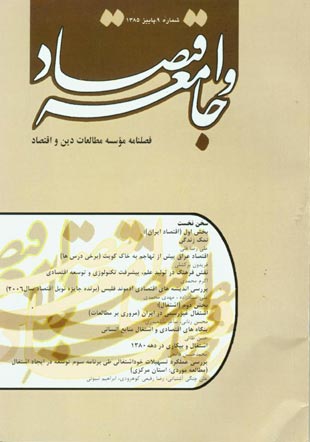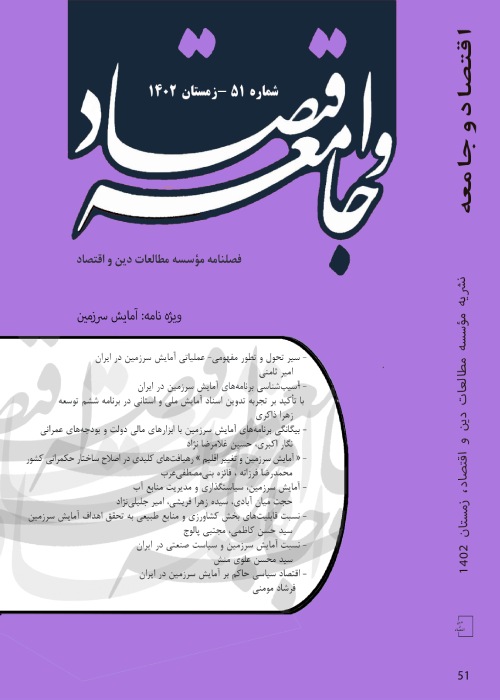فهرست مطالب

نشریه اقتصاد و جامعه
پیاپی 9 (پاییز 1385)
- 206 صفحه، بهای روی جلد: 20,000ريال
- تاریخ انتشار: 1386/02/01
- تعداد عناوین: 9
-
صفحه 4
- بخش اول (اقتصاد ایران و جهان)
-
صفحه 8
- بخش دوم (اشتغال)
-
صفحه 142
-
Page 8The Problem of long experience of underdevelopment phenomenon in contemporary history of Iran, with its geo-political strategic location, has been a source of controversy among the researchers.Institutionalism provides a Sound analytical framework for this controversy. Rezagholi (2004) is an attempt to provide an account of the origins of the problem. Both New and Old Institutionalism Consider the interaction of “individual” and “institutional Structure” as a crucial source for stability and change. The later explains this interaction based on a historical Knowledge and is impressed by historical school. Friedrich List, as an example, takes “production forces” as the analytical framework to explain this interaction. This article, in reference to historical-sociology of Iran’s economy, provides an institutional justification for underdevelopment in Iran. Then, it goes on to look at the experiences of Mir-Mostafa Aalinasab, as a developmentalist producer, once he encountered with the institutional structures in his fruitful life. The article is concluded with a summary review of this upright socioeconomic character of the contemporary Iran.
-
Page 28After the eightyears imposed war to Iran, Saddam’s regine started to reconstruct Iraq’s economy. Iraqi’s government carried out a series of structurl reforms and liberalization. This enterprise exacerbated Iraq’s foreign reserves and resulted in economic irregularities and hyperinflation in that country. The ruling government of Iraq invaded Kuwait with this illusion that with its military might and blackmailing that country, overcoming the deep-rooted economic problems of the country is not farfetched. In analyzing Iraq motivations to invade Kuwait, it has mainly been focused on the political aspects of the invasion and the economic contexts and factors are mainly ignored. This article tries to bring forward an economic account of this invasion.
-
Page 38Historical Studies have shown that the suientific, technological, and economic developments wholly depend upon the cultural environment, growth of knowledge, development of the public understanding of knowledge. This dependency has grown more raidly than the knowledge growth, and the more scientific advanced countries could turn these achievement into more economic development.Growth of knowledge and technology, that of application of logical thought and the advanced devices and appliances, have exposed different societies to cultural change and have motivated values such as rationality, scientism, individualism, freedom, secularism.They in turn have Provided more dynamism and mobility in human societies and brought forward more scientific and technadogical innovation. These advancements in the realems of science and technology affected the world views of the people, Particularly scientists, Planners, economic decision makers, enterprenears, and so on, that in turn provided more furtile grounds for further economic development. This article reviews the impact of culture on Production of knowledge, Technological advancement and economic development, Following introducing the core concepts, the interaction of culture and economic development is studied from different sociological school of thoughts. Once, the appropriate cultural values for production of science and economic development are recognized, then the obstacles of flourishing these values in Iran are introduced.
-
Page 60Since 1960s, Edmund pheleps’ contribution to macroeconomics has made great impact on the dominant views in this field. His effort culminated to his Nobel Prize in Economics in 2006. This article reviews his main contributions in two sections. First, relationship between unemployment and inflation and his contribution to rectify Philips Cruve is Considered. His main finding in this relation is that the long run unemployment rate is not affected by monetary and fiscal policies. His analysis revealed the main limitations of demand management approach. The second section deals with Pheleps’ work in capital accumulation and its Golden rule. It is shown that there is a rule of thumlo indicates that in the long run, savings rate should be equal to the capital share in national income. He introduces a condition in which all gaverations are beneficiaries of chnges in Saving rates. Moreover, he analysed the role of human capital in economic growth by arguing that an educated, well-trained workforce is better equipped to adopt new technologies.
-
Page 78e first section of this article focuses on the concept of informal sector in the economy and distinguishes this concept from the other concepts related to the activities beyond the formal sector (such as I nformal economy, unorganized sector, black economy, underground evonomy and informal sector). The second section explains informal sector in the economy and has a glance at the conditions and contexts of the formation of the informal sector in Iran. Then it goes on to provide a summary review on the other countries experiences and to provide a thorough review of the most important studies carried out about the informal activities in Post-Revolution Iran. The criterion selection of these studies has been the centrality of the informal sector or informal employment. The article is concluded with a summary result of the findings of the reviewed papers.
-
Page 124This article focuses on one of the most pivotal Socio-economic topics related to unemployment Problem, that is, “writing the main Place of dispute”. Once unemployment question is considered in Iranian Public, People attentions are diverted toward the labour market, while “employment” is a product of different activities, decisions and combinations of Production factors well beyond labour market. A Firm Production is a Product of the interactions of different factors and agencies in the conventional economic markets. Every factor has its own unique contribution and each market obeys its own specific mechaniem. As a result “employment” and “labour demand” are multifaceted phenomend and once they are analysed all other contributing factors should be taken into account. Economic Firms in Iranion economy are responsible to create millions of Jobs in the near future. Thire roles in the contemporary world of knowledge-based economy and hi-technology require more attention and care. In this enterprise, governments, firms and households have extremely important roles to play.
-
Page 142The labour market Studies in different countries reveal that unemployment, particularly among the youth, women, and university garaduates, is more or less a prevalent problem in different countries, especially in developing countries. Downsizing, technological advanoement and tandency towards capital intensive investments, higher competition among different countries and multinational companies led to extensive labour demand in world scale. In the third and fourth Five Year Plans in Iran it has been emphasized that government should reduce five percent of its staff annually. Some restrictions on government recruitment introduced while higher education system has been Providing training for Salary employment. In other words, the gap between Public sector demand and the market supply has been widening. Experiences of the other countries, such as Germany, Sweden, china, Philipin and Vietnam, in expanding their informal markets, and labour training, and the promotion of self-employement can Provide a fruitful reference framework for Iran. The declinig Presence of the State in demand side for educated labour supply, expansion of the higher education system, increase in women Participation, changes in monetary and fiscal policy and credit rationing in the Postrevolution Iran, all and all, have been carried out while ignoring the labour market Structure. More important, rigidity of the higher-education system for change, Pointed out that there has been no incentive for the labour market to hier new labour force or if it did, it has been so minute that it did not lead to a decisive impact on unemployment rate.
-
Page 174Third Five Year Plan, Started in 2000, has Placed major emphasis on employment generation and outlined a number of policy measures to reduce the growing employment pressures. The Government began to Provide facilities and directed credit to the unemployed and employees under the banner of Self- Employment Credit Program and Rapid Employment Scheme. As a second industrial province in the country, the central Province has a great potential to absorb well as unskilled labors. This province has experienced the lowest unemployment rate following West and East Azarbayejan and Yazd. This article evaluates the effectiveness of the Self-Employment Program in Job Creation during the third five year Plan in the Central province. To this end, based on a designed questionnaire a sample data has been collected. The results drawn from the questionnaire show that sixty-two percent of those who used the self-employed credit had permanent job and twenty-eight percent had temporary job.


